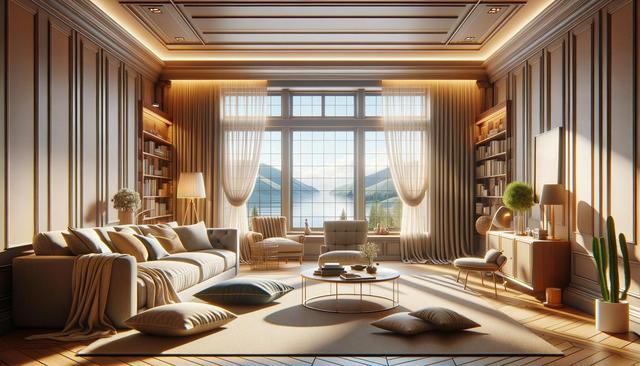Understanding Light Control Through Window Treatments
One of the most practical reasons to invest in window treatments is for light control. Natural light can enhance a room’s ambiance, but without proper management, it can also cause glare, fade furnishings, and disrupt your daily routines. Window treatments allow you to fine-tune how much light enters a space, contributing to better comfort and functionality. From sheer curtains that diffuse sunlight to blackout drapes that block it entirely, there’s a wide range of options to suit varying needs. For example, layered treatments combining shades and curtains give homeowners flexibility throughout the day.
Different materials and designs offer distinct levels of light filtration. Some common types include:
- Sheer panels: Allow soft light while reducing glare.
- Room-darkening shades: Block most light, ideal for bedrooms and media rooms.
- Blackout curtains: Prevent nearly all light from entering, providing maximum darkness.
By choosing the right window treatment, you can create a balance between natural illumination and privacy, all while preserving your home’s interior from UV damage.
Enhancing Privacy Without Sacrificing Style
Privacy is another essential consideration when selecting window treatments. The right solution ensures your home feels secure and secluded, without turning it into a closed-off space. This is especially relevant for rooms facing the street or neighboring properties. Fortunately, there are many attractive options that provide privacy without compromising style. For instance, top-down bottom-up shades offer coverage while still allowing natural light to enter from the top of the window.
Some of the most effective privacy-enhancing window treatments include:
- Frosted or textured films: Maintain brightness while obscuring the view.
- Roman shades: Provide a clean, elegant look with adjustable privacy.
- Cellular shades: Offer excellent privacy and insulation benefits.
When choosing a privacy solution, consider the room’s purpose. Bathrooms and bedrooms typically require higher levels of coverage, while living rooms might benefit from more flexible options that balance openness with discretion.
Choosing Window Treatments for Different Room Needs
Every room in your home has unique requirements when it comes to window treatments. Understanding these needs can help you make informed decisions that combine both function and design. For example, kitchens often benefit from moisture-resistant materials and easy-to-clean surfaces, while living rooms may call for layered treatments to adapt to varying light throughout the day.
Here are a few room-specific suggestions:
- Living Rooms: Layered drapery with light-filtering sheers and heavier panels for versatility.
- Bedrooms: Blackout shades or curtains for restful sleep.
- Kitchens: Faux wood blinds or roller shades for durability and easy maintenance.
- Home Offices: Adjustable treatments like Venetian blinds to reduce screen glare.
When selecting treatments, also consider how the design complements your existing décor. Matching colors, patterns, and textures can tie a room together, enhancing both aesthetic and utility.
Material and Fabric Considerations
The material of your window treatment greatly influences both its appearance and performance. Fabric choices can affect light diffusion, insulation, and ease of care. Heavier materials like velvet or brocade offer a more formal look and better insulation, while lighter fabrics such as linen or cotton create a casual, airy feel. Additionally, synthetic fabrics often offer more durability and resistance to fading, making them suitable for high-traffic or sun-exposed areas.
Key factors to consider when choosing materials include:
- Light control needs: Thicker fabrics block more light.
- Privacy requirements: Denser weaves provide better coverage.
- Maintenance: Some materials are machine washable, while others require dry cleaning.
It’s also worth considering eco-friendly fabrics such as organic cotton or recycled materials. These can offer a sustainable option while still meeting your design and functional goals.
Blending Functionality with Interior Design
Window treatments are not just functional elements; they are also a major design feature in any room. The right treatment can enhance a space, add color or texture, and serve as a focal point. Whether you prefer a contemporary look with clean lines or a more traditional style with rich fabrics and layered drapery, there are options to suit every taste.
To ensure your window treatments complement your interior:
- Match hardware finishes with other room elements.
- Coordinate fabric colors with your overall palette.
- Use patterns to add visual interest or break up solid color schemes.
Ultimately, your choice of window treatment should reflect both your personal style and the practical needs of the space. By thoughtfully blending aesthetics with functionality, you can create rooms that are both beautiful and comfortable.
Conclusion
Window treatments offer a practical and stylish way to manage light and privacy in your home. Whether you’re updating a single room or designing an entire space, considering factors like material, functionality, and style will ensure you make a choice that enhances your lifestyle. From sheer panels to blackout curtains, every option plays a role in creating a balanced and comfortable environment. With thoughtful selection, your window treatments can do more than just cover your windows—they can elevate your home’s interior and support your everyday comfort.




Leave a Reply